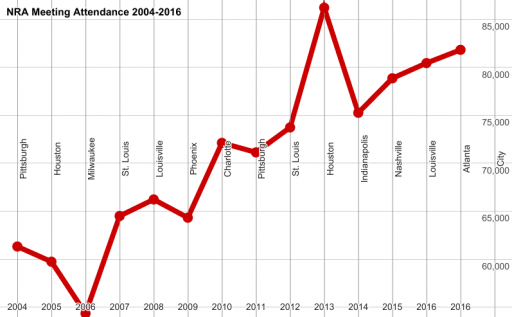I really wish that the anti-gun groups would take an actual detailed account of how many participants they have their anti-NRA protests for annual meeting each year so we could compare. Somehow, I don’t think their graph would look like this one.
This is based on data I’ve been tracking since I attended my very first NRA Annual Meeting in 2004. (I just realized the error in the title with the years. I clearly forgot to update that, but the numbers include Atlanta in 2017, even though that also says 2016 at the bottom. Sorry! It’s fixed in the spreadsheet for next year…)
Other data points that I keep in the spreadsheet that aren’t in this chart is how much the NRA annual meeting has grown since that first one I attended way back when. It’s now 33.5% larger in terms of attendance compared to Pittsburgh 2004. Each time we revisit a city, the number of attendees has gone up between 14% and 44%.
It’s almost like the more that people learn about what NRA is really doing, the more they are on board.


“It’s almost like the more that people learn about what NRA is really doing, the more they are on board.”
Is it that, or more of a broader-based populist appeal? I have been known to comment negatively on their invitations to social conservative celebrities as attractions (e.g., Gen. Boykin, Rev. Franklin Graham) as attractions, despite those people having little or no involvement in guns or gun rights. But, they “fit a profile” that would seem to serve marketing purposes to an increasingly stereotypical audience.
If what “people learn about what NRA is really doing” is, that the NRA is supporting the shooting sports and gun rights, and that’s paying off, that’s great. If what they’re learning is that the NRA is transitioning from being a gun rights organization that leans conservative, to being a conservative organization that happens to also support gun rights, that can narrow its base in the long run, and conceivably alienate a lot of people it might otherwise attract, or at least, count on for tacit political support.
As with our earlier discussions about the USCCA disinvitation from the Meetings, it could be a marketing decision that appears to pay off in short term profits, while incurring long term, hidden political costs.
I failed to say, THANK YOU, for doing this! I enjoy the analysis!
Where is the meeting in 2018?